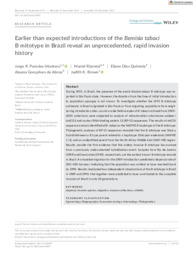Earlier than expected introductions of the Bemisia tabaci B mitotype in Brazil reveal an unprecedented, rapid invasion history.
Earlier than expected introductions of the Bemisia tabaci B mitotype in Brazil reveal an unprecedented, rapid invasion history.
Autoria: PAREDES-MONTERO, J. R.; RIZENTAL, M.; QUINTELA, E. D.; ABREU, A. G. de; BROWN J. K.
Resumo: During 1991, in Brazil, the presence of the exotic Bemisia tabaci B mitotype was re -ported in São Paulo state. However, the duration from the time of initial introduction to population upsurges is not known. To investigate whether the 1991 B mitotype outbreaks in Brazil originated in São Paulo or from migrating populations from neigh -boring introduction sites, country-wide field samples of B. tabaci archived from 1989-2005 collections were subjected to analysis of mitochondrial cytochrome oxidase I (mtCOI) and nuclear RNA- binding protein 15 (RP- 15) sequences. The results of mtCOI sequence analysis identified all B. tabaci as the NAFME 8 haplotype of the B mitotype. Phylogenetic analyses of RP- 15 sequences revealed that the B mitotype was likely a hybrid between a B type parent related to a haplotype Ethiopian endemism (NAFME1-3), and an unidentified parent from the North Africa- Middle East (NAF-ME) region. Results provide the first evidence that this widely invasive B mitotype has evolved from a previously undocumented hybridization event. Samples from Rio de Janeiro (1989) and Ceará state (1990), respectively, are the earliest known B mitotype records in Brazil. A simulated migration for the 1989 introduction predicted a dispersal rate of 200-500 km/year, indicating that the population was unlikely to have reached Ceará by 1990. Results implicated two independent introductions of the B mitotype in Brazil in 1989 and 1990, that together were predicted to have contributed to the complete invasion of Brazil in only 30 generations.
Ano de publicação: 2022
Tipo de publicação: Artigo de periódico
Unidade: Embrapa Arroz e Feijão
Palavras-chave: Agroecologia, Bemisia Tabaci, Dispersal, Ecologia Vegetal, Ecossistema, Invasive species, Migration, Mosca Branca, Museum collections, Whitefly
Observações
1 - Por padrão são exibidas publicações dos últimos 20 anos. Para encontrar publicações mais antigas, configure o filtro ano de publicação, colocando o ano a partir do qual você deseja encontrar publicações. O filtro está na coluna da esquerda na busca acima.
2 - Para ler algumas publicações da Embrapa (apenas as que estão em formato ePub), é necessário ter, no celular ou computador, um desses softwares gratuitos. Sistemas Android: Google Play Livros; IOS: iBooks; Windows e Linux: software Calibre.
Acesse outras publicações
Acesse a Base de Dados da Pesquisa Agropecuária (BDPA) para consultar o acervo completo das bibliotecas da Embrapa.

